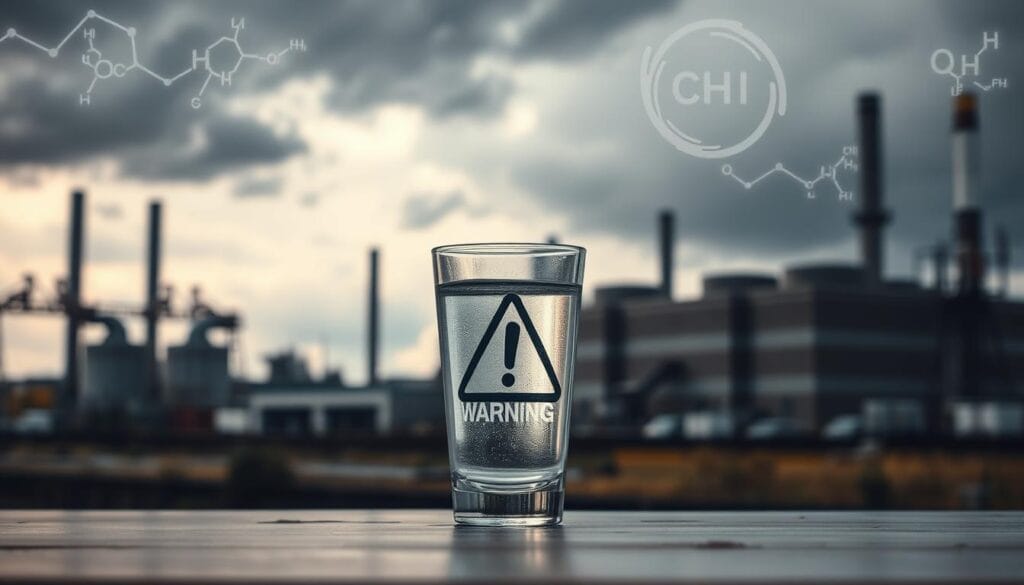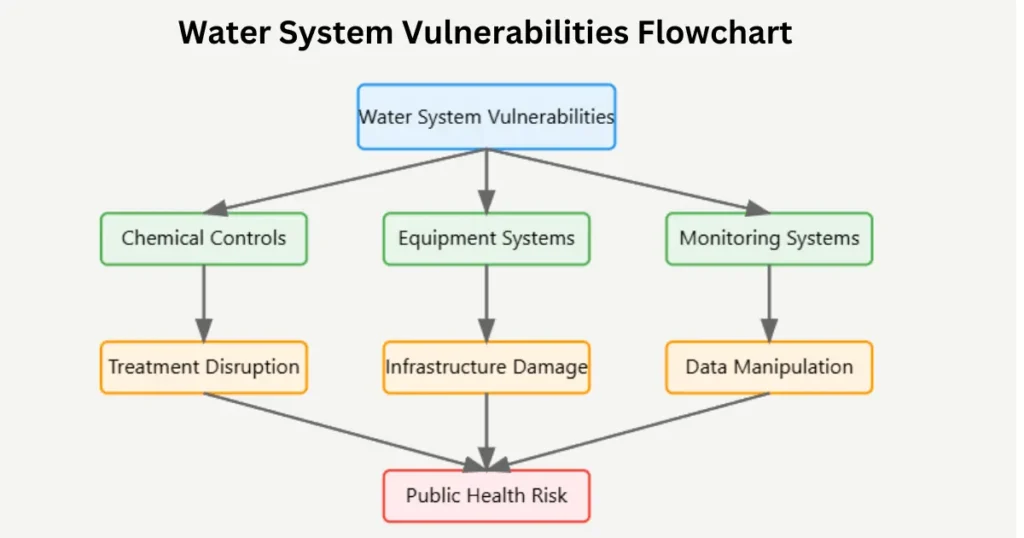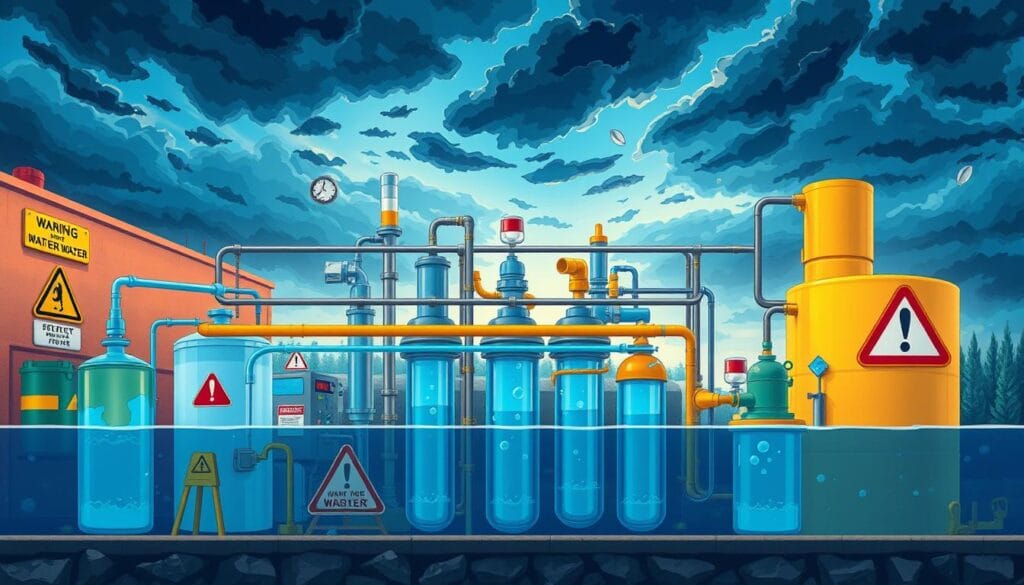Critical Alert: EPA Reveals Widespread Vulnerabilities in American Water Infrastructure
Last Updated: February 21, 2025 | Author: [Dr. Allaoui Nouha] | Review Status: Verified by Water Safety Experts
Introduction
A drinking water warning issued nationwide by the EPA has raised concerns over cyber threats targeting U.S. water systems. A recent investigation revealed that 70% of water utilities fail to meet cybersecurity standards, putting millions at risk of contaminated drinking water and infrastructure failures.
Cyberattacks on water and wastewater systems have exposed critical vulnerabilities. Threat actors from China, Russia, and Iran have been linked to these attacks, which could disrupt treatment processes, alter chemical levels, and damage essential water infrastructure. As most Americans rely on tap water, this warning highlights serious public health concerns.
To address this crisis, the EPA and White House are taking urgent action, strengthening water system cybersecurity, improving risk assessments, and enhancing emergency response strategies to protect the nation’s drinking water supply.
Table of Contents
🚨 Quick Action Guide – What You Need to Know Now
| Immediate Actions | Why It Matters |
|---|---|
| Check local water advisories | Your area may be affected |
| Sign up for alerts | Stay informed about changes |
| Consider water testing | Ensure your safety |
| Review emergency supplies | Be prepared for disruptions |
Key Statistics At a Glance:
- 70% of water systems fail cybersecurity standards
- 26.6 million Americans served by high-risk systems
- $43.5 billion potential economic impact per day of disruption
- 97 systems identified with critical vulnerabilities
Understanding the Nationwide Drinking Water Warning
The Environmental Protection Agency (EPA) has issued an unprecedented drinking water warning issued nationwide, revealing alarming vulnerabilities in America’s water infrastructure. This critical alert comes after discovering widespread cybersecurity gaps that could affect millions of households across the United States.
Scope of the Crisis
The investigation uncovered three levels of risk:
- High-Risk Systems:
- 97 water systems affected
- 26.6 million people impacted
- Critical vulnerabilities identified
- Medium-Risk Systems:
- 211 systems compromised
- 82.7 million people served
- Significant security gaps present
- Low-Risk Systems:
- Remaining systems require updates
- Preventive measures needed
- Ongoing monitoring essential

Cyber Threats to Our Water Supply
State-Sponsored Attacks Identified
Foreign Threat Actors:
- Chinese group “Volt Typhoon”
- Iranian “Cyber Av3ngers“
- Russian state-sponsored groups
These threats are a core part of the overall Drinking water warning issued nationwide, emphasizing the need for enhanced security across all water systems.

Health Risks and Safety Concerns
Potential Impact on Public Health
| Risk Type | Potential Consequences | Prevention Measures |
|---|---|---|
| Chemical Manipulation | Incorrect treatment levels | Enhanced monitoring |
| System Disruption | Service interruptions | Backup systems |
| Data Breach | Compromised safety controls | Security protocols |
| Infrastructure Damage | Equipment failure | Regular maintenance |
EPA’s Immediate Action Requirements
Critical Timeline for Water Utilities
- Immediate Actions (Within 30 Days):
- Update all default passwords
- Implement multi-factor authentication
- Conduct initial vulnerability assessment
- Short-term Requirements (90 Days):
- Complete comprehensive security audit
- Develop incident response plan
- Train staff on security protocols
- Long-term Implementation (180 Days):
- Install advanced monitoring systems
- Establish redundant controls
- Create regular testing schedule
Protecting Your Household

Immediate Steps for Families
✅ Check Your Local Status:
- Contact your water provider
- Review recent water quality reports
- Sign up for emergency notifications
✅ Emergency Preparedness:
- Store emergency water supply
- Install water quality monitors
- Keep filtration systems updated
✅ Regular Monitoring:
- Test water quality monthly
- Watch for unusual changes
- Report suspicious activities
Government Response and Resources
Federal Support Programs
The Biden Administration has allocated significant resources to address this crisis:
- $50 billion infrastructure investment
- 24/7 cybersecurity monitoring
- Nationwide training programs
- Free technical support for utilities
Stay Informed: Latest Updates
Real-time Monitoring Resources
📱 Digital Tools:
- EPA Water System Look-up Tool
- Local Water Quality Dashboard
- Emergency Alert System
- Community Response Network
FAQ: Common Concerns Addressed
Q: How do I know if my water is safe?
A: In light of the Drinking water warning issued nationwide, check your local water utility’s website for current advisories and test results. Stay updated on any alerts tied to the Drinking water warning issued nationwide and consider regular home testing to ensure water safety.
Q: What immediate actions should I take?
A: Under the Drinking water warning issued nationwide, monitor official announcements closely, maintain an emergency water supply, and consider installing a certified water filtration system. These steps are crucial to safeguard your household during the period of the Drinking water warning issued nationwide.
Q: How long will this warning last?
A: The EPA will maintain the Drinking water warning issued nationwide until water systems meet the updated cybersecurity and safety standards. The timeline varies by region, but the Drinking water warning issued nationwide will remain active as long as critical vulnerabilities persist.
Take Action Now
Community Response Checklist
- [ ] Check local water system status
- [ ] Sign up for emergency alerts
- [ ] Review household emergency plans
- [ ] Share updates with neighbors
- [ ] Report suspicious activities
Resources and Support
Official Channels for Updates
- EPA Hotline: 1-800-XXX-XXXX
- Website: www.epa.gov/watersafety
- Local Utility Finder: [Search Tool]
- Emergency Updates: Text WATER to 12345
Conclusion
The Drinking water warning issued nationwide represents a critical moment for American infrastructure security. While the challenges are significant, coordinated action between government agencies, water utilities, and informed citizens can help protect our essential water systems.
Stay informed, take recommended precautions, and participate in community preparedness efforts. Together, we can ensure the safety and security of our water supply.
Sources:
- Environmental Protection Agency (EPA)
- Department of Homeland Security
- US Water Alliance
- Cybersecurity and Infrastructure Security Agency (CISA)


3 thoughts on “URGENT: Drinking Water Warning Issued Nationwide – 70% of US Systems Under Cyber Attack Risk”
Comments are closed.